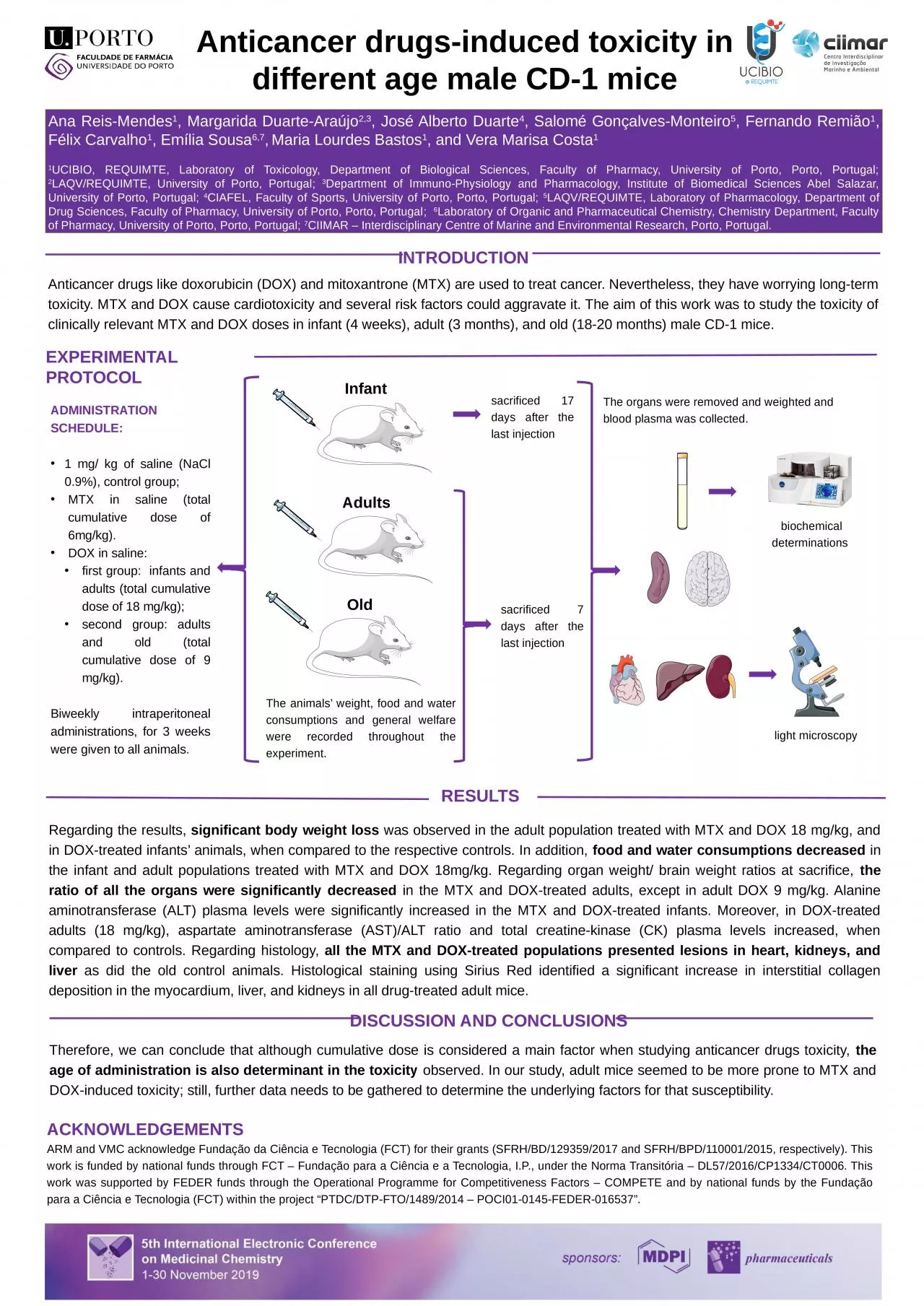

Introduction Anticancer drugs like doxorubicin DOX and mitoxantrone MTX are used to treat cancer Nevertheless they have worrying longterm toxicity MTX and DOX cause cardiotoxicity and several risk factors could aggravate it The aim of this work was to study the toxicity of clinically rel ID: 920209
Download Presentation The PPT/PDF document "Anticancer drugs-induced toxicity in dif..." is the property of its rightful owner. Permission is granted to download and print the materials on this web site for personal, non-commercial use only, and to display it on your personal computer provided you do not modify the materials and that you retain all copyright notices contained in the materials. By downloading content from our website, you accept the terms of this agreement.
Slide1
Anticancer drugs-induced toxicity in different age male CD-1 mice
Introduction
Anticancer
drugs like doxorubicin (DOX) and mitoxantrone (MTX) are used to treat cancer. Nevertheless, they have worrying long-term toxicity. MTX and DOX cause cardiotoxicity and several risk factors could aggravate it. The aim of this work was to study the toxicity of clinically relevant MTX and DOX doses in infant (4 weeks), adult (3 months), and old (18-20 months) male CD-1 mice.
Experimental protocol
Results
Discussion and conclusions
Regarding the results,
significant body weight loss
was observed in the adult population treated with MTX and DOX 18 mg/kg, and in DOX-treated infants’ animals, when compared to the respective controls. In addition,
food and water consumptions decreased
in the infant and adult populations treated with MTX and DOX 18mg/kg. Regarding organ weight/ brain weight ratios at sacrifice,
the ratio of all the organs were significantly decreased
in the MTX and DOX-treated adults, except in adult DOX 9 mg/kg. Alanine aminotransferase (ALT) plasma levels were significantly increased in the MTX and DOX-treated
infants.
Moreover, in DOX-treated
adults
(18 mg/kg), aspartate aminotransferase (AST)/ALT ratio and total creatine-kinase (CK) plasma levels increased, when compared to controls. Regarding histology, all the MTX and DOX-treated populations presented lesions in heart, kidneys, and liver as did the old control animals. Histological staining using Sirius Red identified a significant increase in interstitial collagen deposition in the myocardium, liver, and kidneys in all drug-treated adult mice.
Therefore, we can conclude that although cumulative dose is considered a main factor when studying anticancer drugs toxicity, the age of administration is also determinant in the toxicity observed. In our study, adult mice seemed to be more prone to MTX and DOX-induced toxicity; still, further data needs to be gathered to determine the underlying factors for that susceptibility.
AcknowledgementsARM and VMC acknowledge Fundação da Ciência e Tecnologia (FCT) for their grants (SFRH/BD/129359/2017 and SFRH/BPD/110001/2015, respectively). This work is funded by national funds through FCT – Fundação para a Ciência e a Tecnologia, I.P., under the Norma Transitória – DL57/2016/CP1334/CT0006. This work was supported by FEDER funds through the Operational Programme for Competitiveness Factors – COMPETE and by national funds by the Fundação para a Ciência e Tecnologia (FCT) within the project “PTDC/DTP-FTO/1489/2014 – POCI01-0145-FEDER-016537”.
Infant
The organs were removed and weighted and
blood plasma
was collected.
The
animals’ weight, food and water consumptions and general welfare were recorded throughout the experiment.
Adults
Old
sacrificed
17 days after
the last injection
sacrificed 7 days after the last injection
administration schedule:
1
mg/ kg of saline (
NaCl
0.9
%), control
group
;
MTX
in saline (total cumulative dose of 6mg/kg).
DOX
in saline:
first
group:
infants
and adults (total cumulative dose of 18 mg/kg
);
second
group: adults and old (total cumulative dose of 9 mg/kg
).
Biweekly intraperitoneal
administrations, for 3
weeks were
given to all
animals.
biochemical determinations
light microscopy
Ana Reis-Mendes
1
, Margarida Duarte-Araújo
2,3
, José Alberto Duarte
4
, Salomé Gonçalves-Monteiro
5
, Fernando Remião
1
, Félix Carvalho
1
, Emília Sousa
6,7
,
Maria Lourdes Bastos
1
, and Vera Marisa
Costa
1
1
UCIBIO
, REQUIMTE, Laboratory of Toxicology, Department of Biological Sciences, Faculty of Pharmacy, University of Porto, Porto, Portugal;
2
LAQV/REQUIMTE, University of Porto,
Portugal
;
3
Department of Immuno-Physiology and Pharmacology, Institute of Biomedical Sciences Abel Salazar, University of Porto, Portugal;
4
CIAFEL, Faculty of
Sports,
University of Porto, Porto, Portugal;
5
LAQV/REQUIMTE, Laboratory of Pharmacology, Department of Drug Sciences, Faculty of Pharmacy, University of Porto, Porto, Portugal
;
6
Laboratory of Organic and Pharmaceutical Chemistry, Chemistry Department, Faculty of Pharmacy, University of Porto, Porto, Portugal;
7
CIIMAR – Interdisciplinary Centre of Marine and Environmental Research, Porto, Portugal.